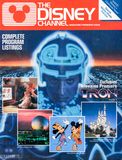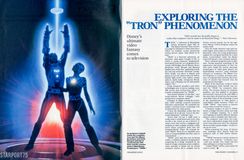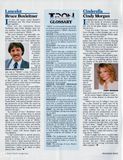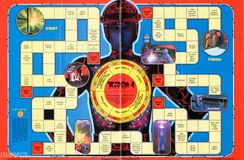"TRON," a milestone in filmmaking history, premieres April 18th on The Disney Channel. Then viewers can judge for themselves what critics have called “an original, unique, pioneering motion picture-giant steps ahead of its time."
“TRON" is a futuristic adventure, an electronic video game brought to life, in which a young computer programmer faces death from the very programs he invented. Jeff Bridges, David Warner, Bruce Boxleitner, Cindy Morgan and Barnard Hughes have dual roles, appearing in both the real and awesome electronic worlds. Their deadly war game is played with pieces no eye nor camera has ever before beheld: light-cycles, solar sailors, energy spheres, battle tanks, anti-gravity Recognizers, and a floating unit of information called a “bit."
Using computer graphics and other technologies new to movie making, some 400 artists and technicians spent 15 months creating scenes for “TRON."
“And sixteen minutes of this film,” says writer-director Steven Lisberger, “were produced by computers alone!"
Lisberger, 32, began writing the screenplay while making computer-animated television commercials. He combined the public's wariness of new technology with its fascination for video games.
“I have the disturbing notion that bits and pieces of us all now exist in the electronic dimension," Lisberger says.
“Every time we use a bank card, a credit card, a word processor, every time we file a tax return or get a driver’s license, every time we buy a magazine subscription or open a charge account, a little more about ourselves goes into the ComputerWorld. T hat's the concept behind “TRON.” Parts of our identities now exist in ComputerWorld and they want to communicate.
“TRON" turns that idea into terrifying reality: a brilliant computer programmer, suspecting he is being victimized by the head of a huge communications conglomerate, attempts to break into its central computer system. He is stopped, not by human security guards, but by the ingenious Master Control Program within the system itself.
Thus the battle between man and machine begins. And it takes on a fearful new dimension when the young programmer, zapped into energized particles by a laser beam, rematerializes inside the Master Control Program's vast computer domain.
There computer programs exist as identities, having acquired something of the appearance and personality of their human users. Inside the system, electronic counterparts of video game players are death-dealing warriors, using computer software as weaponry. The Master Control Program is a sinister, pervasive presence. It is against these enemies, the inventions of people like himself, that the programmer must fight.
Much of the electronic world in which the programmer finds himself was created for “TRON” by computers themselves. The process, known as computer graphics, was first applied to aerospace and scientific research in the mid-1960's. It has since been diverted into the entertainment field. Some of the technology is used in the manufacture of video games, a multi-billion dollar business. (There are 25,000 “TRON" video games in theatres and arcades around the country.)
“Computer imagery as seen in “TRON" forms a bridge between artists and engineers,” Lisberger explains. “As a result we're getting an entirely different interpretation of what is aesthetic and what is art.
“The computer won’t draw for a person, but it will produce images that would never exist otherwise. Once the computer shows us these unique images, we can create on our own."
When mustering his army of innovators, Lisberger drew heavily from the technical staff of Walt Disney Productions.
“TRON ”represents a timely advance in Disney film making," Lisberger says, “with new people, new minds and new ideas adding to a strong foundation.
I think “TRON " will be a pace-setter for years to come."



